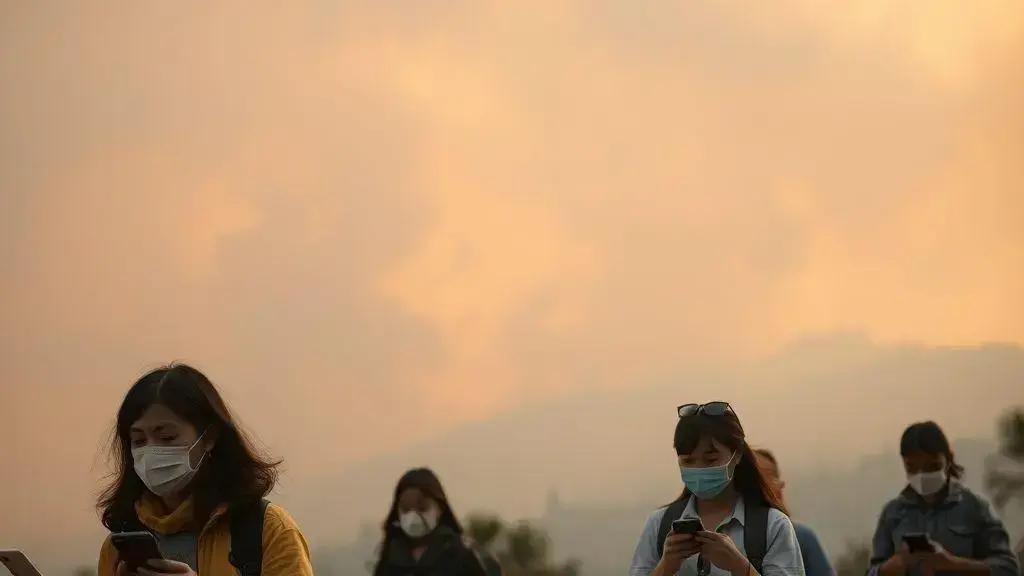Wildfire smoke health advisories: what you need to know

Wildfire smoke health advisories are critical alerts that inform individuals about air quality risks, guiding them on necessary precautions to protect their health during smoke events.
Wildfire smoke health advisories have become increasingly important as wildfires intensify. These advisories play a crucial role in guiding us on how to protect our health during smoke events. Have you ever wondered how these alerts can help you stay safe?
Understanding wildfire smoke and its composition
Understanding wildfire smoke and its composition is crucial for knowing how it affects our health and environment. Wildfires release various particles and gases into the air, creating a unique mixture. This mixture can contain harmful substances that pose risks to our health.
Composition of Wildfire Smoke
The smoke produced by wildfires is made up of two main components: particulate matter and gases. Particulate matter consists of tiny solid particles and liquid droplets that can be inhaled deep into the lungs. The gases include carbon monoxide, volatile organic compounds (VOCs), and other toxic substances. Knowing what these components are helps us understand their potential impacts on health.
Health Risks from Wildfire Smoke
Exposure to wildfire smoke can lead to several health issues, especially for sensitive groups like children and the elderly. Here are some key health risks:
- Increased respiratory problems such as asthma or bronchitis
- Worsening of pre-existing heart conditions
- Eye irritation and skin reactions
- Potential long-term health effects with prolonged exposure
It’s essential to recognize these risks and take necessary precautions when smoke is present. Evacuating or staying indoors with air filtration can help reduce exposure. Understanding the composition of wildfire smoke enables individuals and communities to make informed decisions about their health.
The composition varies depending on the materials burning in the fire. For example, burning vegetation releases different compounds compared to buildings or vehicles. This variation can change how smoke affects air quality and public health.
Health risks associated with wildfire smoke exposure
Health risks associated with wildfire smoke exposure are significant and can vary from person to person. Smoke from wildfires contains numerous harmful components that affect our respiratory system, cardiovascular health, and overall wellbeing. Understanding these risks is essential, especially for individuals with pre-existing health conditions.
Respiratory Problems
One of the most immediate concerns is the impact on the respiratory system. Exposure to wildfire smoke can lead to:
- Increased severity of asthma symptoms.
- Higher rates of respiratory infections.
- Development of new respiratory conditions.
These issues occur because smoke irritates the lungs and airways, making it harder to breathe. People with asthma or chronic obstructive pulmonary disease (COPD) may find their conditions worsening when smoke is present.
Cardiovascular Effects
Wildfire smoke doesn’t just impact the lungs; it also affects the heart. Inhaling particulate matter from smoke can increase the risk of heart attacks and strokes. Here are some cardiovascular effects:
- Increased heart rate and blood pressure.
- Worsening of heart disease symptoms.
- Higher risk for sudden cardiac events.
Individuals with heart conditions should be especially cautious during wildfire events, ensuring they limit their exposure and seek medical advice if necessary.
The symptoms of wildfire smoke exposure can sometimes go unnoticed until they become severe. Other common effects include headaches, nausea, and eye irritation. It’s vital to recognize these symptoms early and take appropriate action.
Protection measures, such as using an air purifier indoors or wearing a mask outdoors, can greatly reduce exposure to harmful smoke particles. Staying informed about air quality alerts can also help keep communities safe during wildfire seasons.
How to stay safe during wildfire smoke events

Staying safe during wildfire smoke events is crucial for protecting your health and well-being. When smoke fills the air, it poses serious risks, especially for vulnerable populations. Knowing how to respond can make all the difference.
Monitor Air Quality
One of the first steps to ensure your safety is to monitor air quality. Stay informed about local air quality indicators, which are typically reported in terms of the Air Quality Index (AQI). Use reliable sources such as:
- Local weather stations.
- Online air quality websites.
- Mobile apps that track air pollutants.
When the AQI indicates “unhealthy” or “very unhealthy” conditions, it’s time to take action.
Limit Outdoor Activities
Reducing your time outdoors during smoke events is vital. Avoid any strenuous activities that can worsen your exposure to smoke. If you must go outside, try to limit your time outdoors, especially during the times when smoke is at its peak. Remember to:
- Plan your activities around smoke levels.
- Stay indoors as much as possible.
Create a cozy indoor environment. Make sure to keep windows and doors closed to limit smoke entry. Using air conditioning can help filter air, but be sure to avoid using systems that draw air from outside.
If the smoke starts to affect you, recognize the symptoms. Common signs include coughing, shortness of breath, and skin irritation. Pay attention to how your body responds and take necessary precautions.
Use Protective Gear
When you do need to be outdoors, consider wearing a mask that filters out fine particles. Masks labeled N95 or P100 can offer better protection against particulate matter. These are designed to fit snugly and filter out harmful pollutants in the air you breathe.
After returning indoors, take off any protective gear and wash your hands. If you have been exposed to smoke, change your clothes to minimize any lingering pollutants.
Finally, if you begin experiencing worsening symptoms, seek medical attention. It’s always better to err on the side of caution during these events.
When to seek medical help during smoke advisories
Knowing when to seek medical help during smoke advisories is vital for your health. Wildfire smoke can cause serious health issues that may require medical attention. It’s important to listen to your body and recognize warning signs.
Recognizing Symptoms
If you experience any of the following symptoms, it may be time to consult a healthcare professional:
- Persistent coughing that doesn’t go away.
- Shortness of breath or difficulty breathing.
- Wheezing or a tight feeling in your chest.
- Severe headaches or dizziness.
These symptoms can indicate that the smoke is affecting your respiratory system or overall health. If you have pre-existing conditions like asthma or heart disease, you may need to monitor your symptoms more closely.
When to Take Action
Do not hesitate to seek medical help if you notice severe symptoms or a significant worsening of any existing conditions. If you find it hard to do your daily activities due to smoke-related issues, it’s advisable to speak with a doctor.
Your safety is paramount, especially during severe smoke events. Follow local health advisories and stay informed about air quality. If you have been exposed to smoke and are concerned about long-term effects, it’s a good idea to have a discussion with your healthcare provider.
Emergency situations can arise, particularly for those at higher risk. Seniors, children, and people with chronic illnesses should take extra precautions and seek help early. Knowing your limits and understanding your health can prevent serious outcomes during wildfire smoke events.
Resources for staying informed about smoke conditions
Staying informed about smoke conditions is key to ensuring your safety during wildfire events. Access to reliable information helps you make informed decisions about your health and well-being. Here are some vital resources you can use.
Government and Local Agencies
Government websites provide valuable updates on air quality and smoke conditions. Local environmental agencies often monitor air quality and issue alerts. Check these resources:
- The Environmental Protection Agency (EPA) website.
- Your local health department’s website.
- State fire management resources.
These agencies frequently provide updates on air quality advisories and health recommendations based on current smoke levels.
Mobile Apps and Notifications
Several mobile applications are available to keep you informed about fire and smoke conditions. Many of these apps offer real-time updates and alerts, helping you stay ahead:
- Air quality monitoring apps like AirNow.
- Weather apps with air quality features.
- Alert systems established by local authorities.
These tools can send notifications straight to your phone, keeping you aware of changing conditions.
Social media is also a great way to stay connected. Follow local fire departments and health officials on platforms like Twitter or Facebook for timely information. They often provide updates and safety tips during smoke events.
Additionally, consider tuning into local news broadcasts for the latest information on the situation in your area. Radio stations frequently give updates on environmental conditions, ensuring you remain informed wherever you are.
Using these resources wisely can help you navigate through wildfire smoke events more safely and effectively, ensuring you protect yourself and your loved ones.
FAQ – Questions Frequently Asked About Wildfire Smoke Health Advisories
What are the health risks associated with wildfire smoke?
Wildfire smoke can cause respiratory issues, worsen heart conditions, and lead to irritation of the eyes and skin. Vulnerable populations are at higher risk.
How can I stay informed about wildfire smoke conditions?
You can monitor air quality through government websites, mobile apps, and local news sources for real-time updates and advisories.
What should I do if I experience symptoms during a smoke event?
If you experience symptoms like coughing or difficulty breathing, seek medical help. Monitor your condition and follow local health advisories.
What protective measures can I take during smoke events?
Stay indoors, use air purifiers, wear masks if you need to go outside, and minimize physical activities to reduce exposure to smoke.





